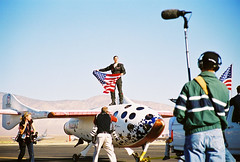
Today marks two important anniversaries in the history of space travel. Fifty years ago today, the Soviet Union launched a beeping basketball sized satellite called Sputnik, and with it the space age. Sputnik was the first artificial satellite, and it lit a fire under the US government. As a result of it, President Eisenhower created the Advanced Research Projects Agency, or ARPA, and the National Aeronautics and Space Administration, or NASA.
NASA, as we all know, went from hardly being able to get a rocket off the ground to landing people on the moon in 12 short years. ARPA, originally charged with furthering US spaceflight technology, ceded that mission to NASA and shifted its focus to advanced computer research, which in turn led to the creation of the Internet right around the time Neil and Buzz made their famous moonwalk in 1969.
NASA astronauts haven't left Earth orbit since 1972. ARPA became the Defense Advanced Research Projects Agency, or DARPA, and is now engaged in cutting edge research in fields like hypersonic jets, vegetable-based aviation fuels and other alternative energy sources, bionic limbs, robot surgeons, intelligent machines, and a lot of other areas that could lead to advances as important as the Internet. DARPA is the subject of my next book. As for space travel....
 Today also marks the three-year anniversary of an event that could have as great an impact as Sputnik. On October 4, 2004, test pilot Brian Binnie, working for Scaled Composites in Mojave, California, flew out of the atmosphere in SpaceShipOne to win the Ansari X PRIZE for back-to-back flights by a privately built manned spacecraft. Less than a week before, Binnie's colleague Mike Melvill had made the first X PRIZE-qualifying flight, and earlier that year, on a June 21st test flight, Melvill had become the world's first commercial astronaut.
Today also marks the three-year anniversary of an event that could have as great an impact as Sputnik. On October 4, 2004, test pilot Brian Binnie, working for Scaled Composites in Mojave, California, flew out of the atmosphere in SpaceShipOne to win the Ansari X PRIZE for back-to-back flights by a privately built manned spacecraft. Less than a week before, Binnie's colleague Mike Melvill had made the first X PRIZE-qualifying flight, and earlier that year, on a June 21st test flight, Melvill had become the world's first commercial astronaut.The commercial space age launched by SpaceShipOne is the subject of my book Rocketeers: How a Visionary Band of Business Leaders, Engineers, and Pilots Is Boldly Privatizing Space (Smithsonian/HarperCollins, 2007).
In celebration of this dual anniversary, I'm giving a talk at the next meeting of the New York Space Society at New York University. If you're in the area, stop by. The meeting is at 4:00 on Saturday, October 6, at the Silver Center for Arts and Science, 32 Waverly Place, room 806. I'll have books to sign.

No comments:
Post a Comment